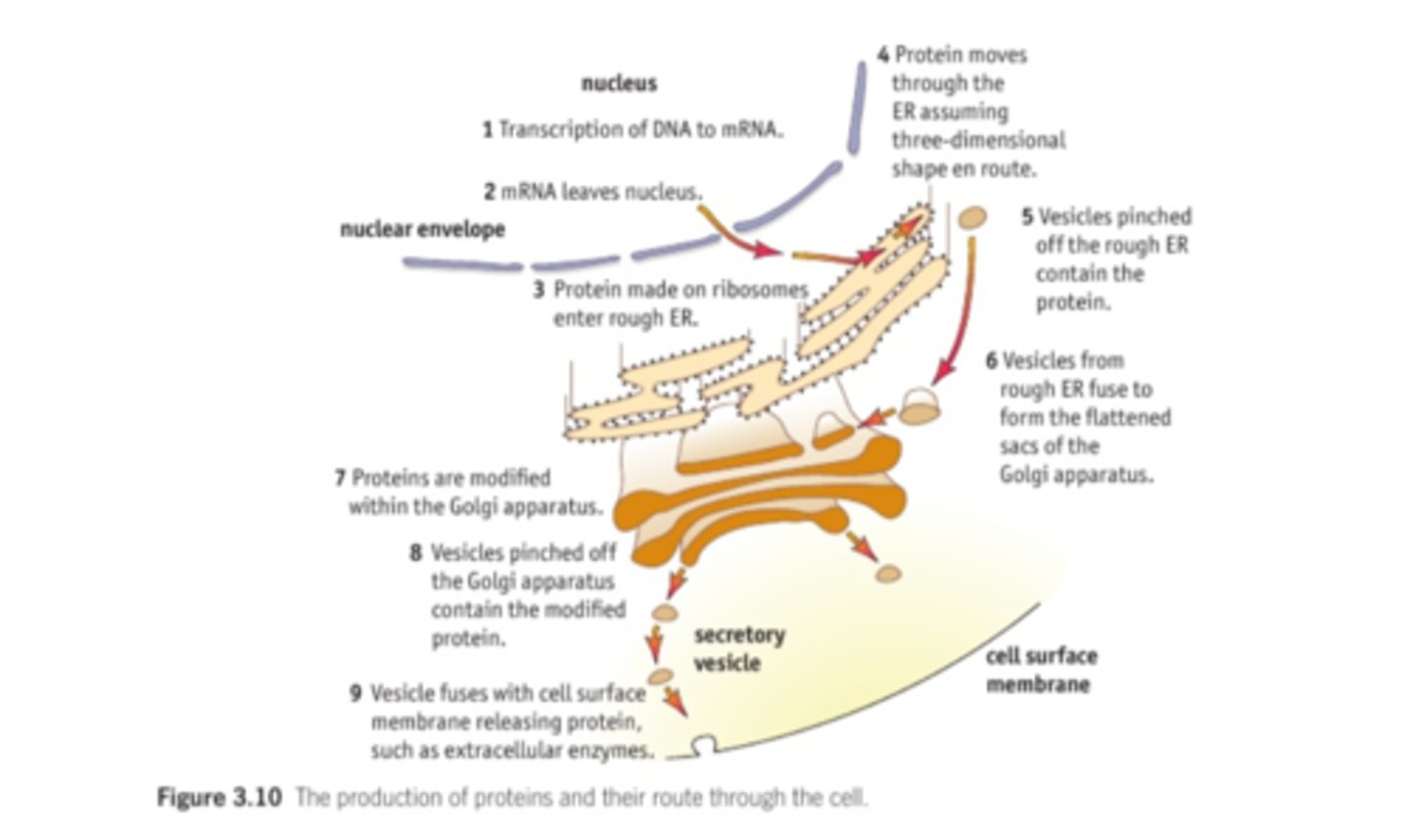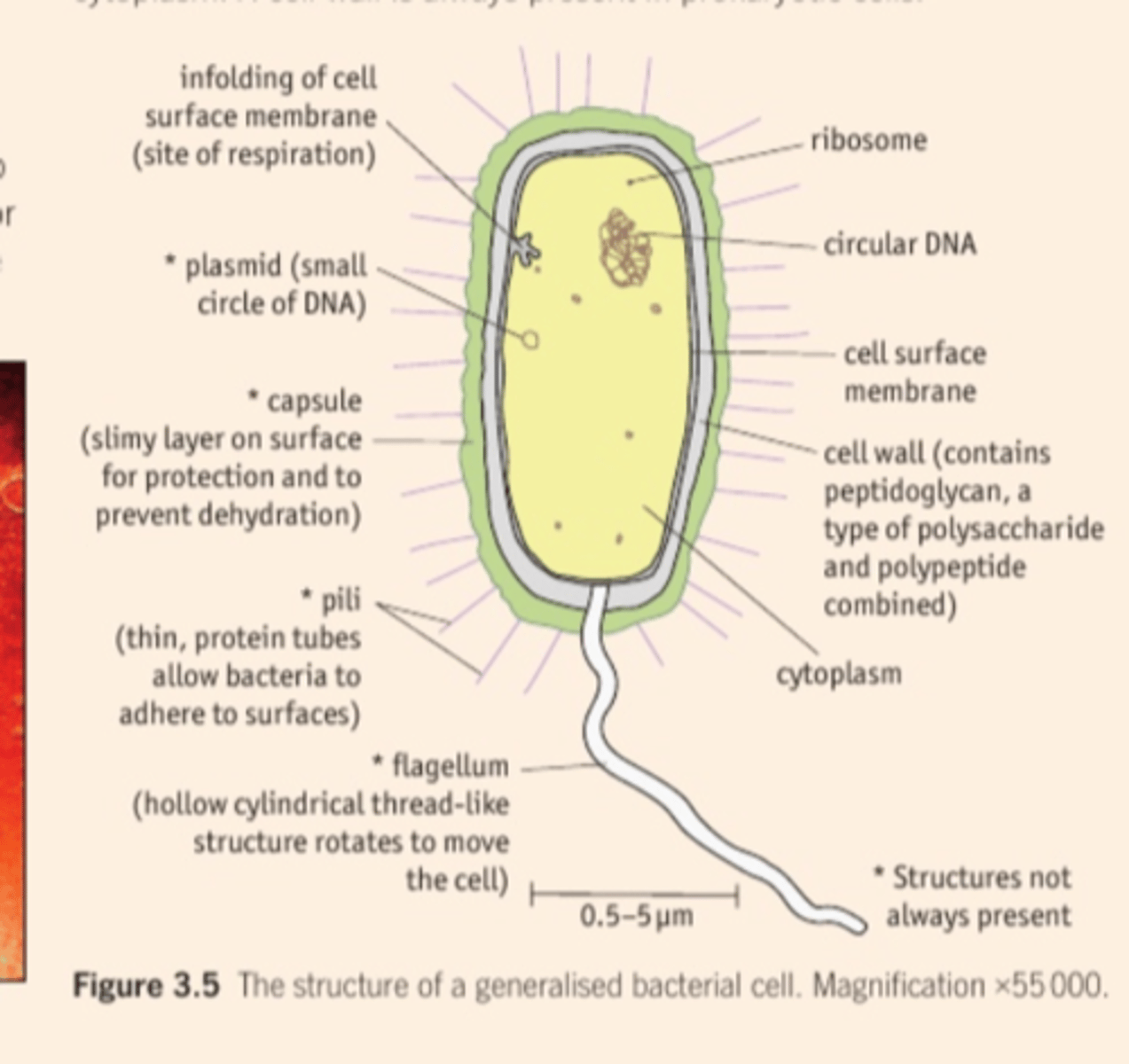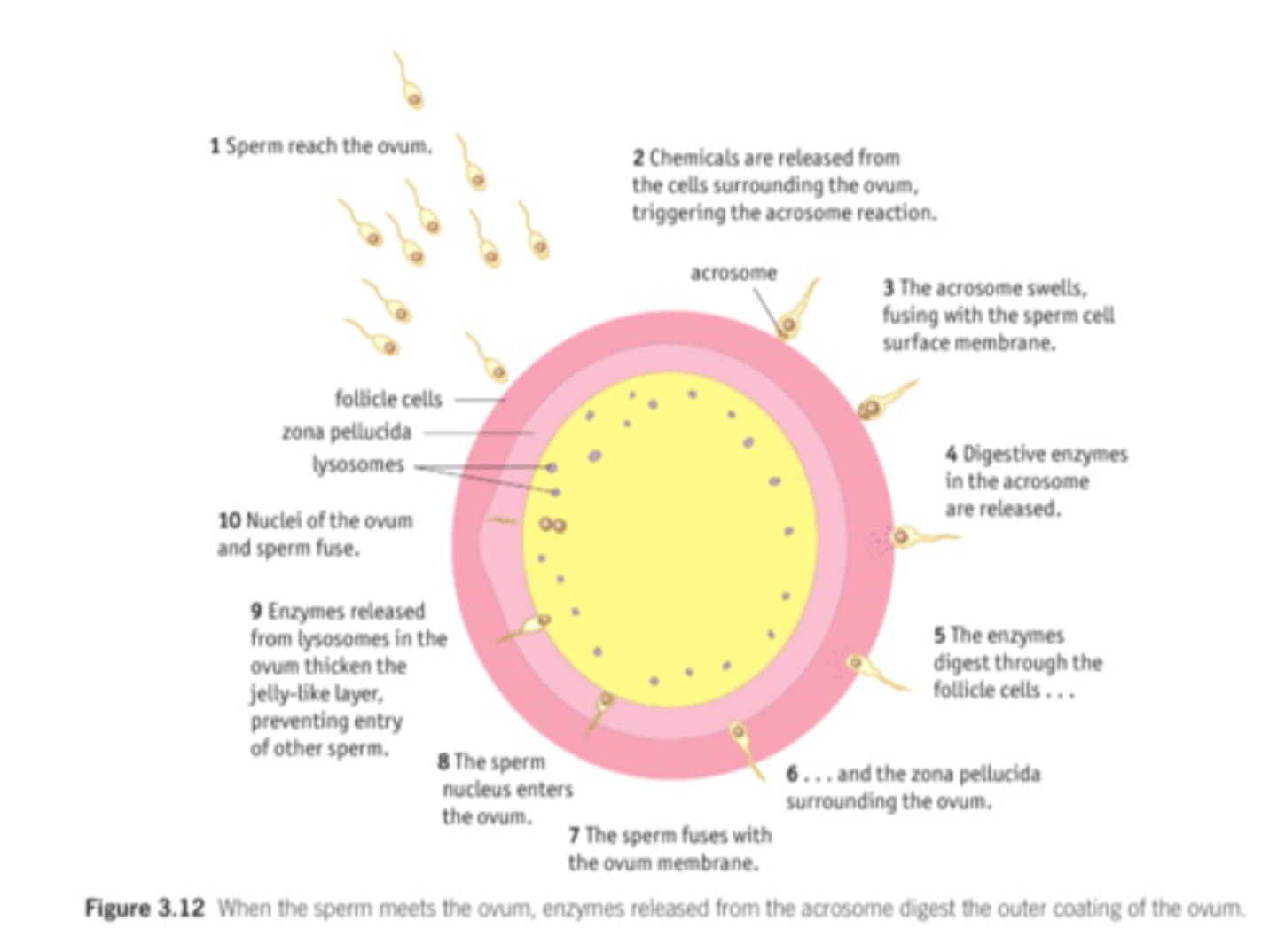SNAB TOPIC 3-Voice of the Genome
1/32
There's no tags or description
Looks like no tags are added yet.
Name | Mastery | Learn | Test | Matching | Spaced |
|---|
No study sessions yet.
33 Terms
3.1 Living organisms
All living things/organisms are made of cells and share some common features:
In multicellular organisms:
Cells-->Tissues-->organs-->systems, each specified for a particular function(s)
3.2 (eukaryotic) Nucleus
Double membrane (nuclear envelope) with nuclear pores
Contains DNA, wrapped around histone proteins
Contains a nucleolus
3.2 80s ribosomes
Composed of two subunits
Site of protein synthesis
3.2 Lysosomes
Vesicles containing digestive enzymes
Bound by a single membrane
3.2 Mitochondria
Oval shaped, bound by a double membrane
Inner membrane folds, forming cristae
Contains enzyme for aerobic respiration
3.2 Golgi apparatus
Series of fluid filled, flattened and curved sacs
Vesicles surrounding edges
Modifies and packages proteins and lipids
Produces lysosomes
3.2 Smooth ER
System of membrane bound sacs
Produces and processes lipids
3.2 Centrioles
Perpendicular cylinders of microtubules
Involved in cell division
3.2 Rough ER
Series of flattened sacs, enclosed by a membrane
Ribosomes attached to the surface
Folds and processes proteins made on the ribosomes
3.3 Understand the role of the rough endoplasmic reticulum (rER) and the Golgi apparatus in protein transport within cells, including their role in the formation of extracellular enzymes.
Proteins are produced on the surface of ribosomes.
Proteins produced are folded and processed in the RER (sugar chains attached)
The proteins are then transported from the RER to the Golgi apparatus in vesicles.
Vesicles fuse with Golgi apparatus
Modification of protein inside Golgi apparatus (more sugar/carbohydrate chains added/trimmed)
Golgi apparatus packages proteins in secretory vesicles for movement by exocytosis
Vesicles fuse with cell surface membrane releasing proteins (e.g. extracellular enzymes)

3.4 Know the ultrastructure of prokaryotic cells - 9
cell wall
cytoplasm
Slime capsule - helps cell retain moisture and adhere to surfaces
plasmids - small circle of DNA
flagellum - rotates to move the cell
pili - attach to other bacterial cells for exchange of plasmids
ribosomes
mesosomes (infolding of cell membrane) - contains enzymes required for respiration
circular DNA

3.5 Be able to recognise the organelles in 3.2 from electron microscope (EM) images.
Circle with blob= nucleus
Small bubbles= vesicles
Oval/circle with pattern= mitochondria
Long, flattened darker lines near nucleus= ER
3.6 Understand how mammalian gametes are specialised for their functions (including the acrosome in sperm and the zona pellucida in the egg).
Ovum:
-Zona pellucida, protective jelly like coating, prevents polyspermy
-Haploid nucleus - full set of chromosomes restored at fertilisation
-Cortical granules, releasing enzymes that harden the zona pellucida
-Follicle cells form a protective coating around the egg.
also has cell membrane
Sperm cell
-Many mitochondria to make energy for flagellum
-Acrosomes contain digestive enzymes that break down the zona pellucida
has plasma membrane inside tail and cell membrane on head
3.7 Know the process of fertilisation in mammals, including the acrosome reaction, the cortical reaction and the fusion of nuclei.
Sperm swim towards egg cell in oviduct
Sperm makes contact with zona pellucida of egg cell
Acrosome reaction occurs
Digestive enzymes released from the acrosome
Enzymes digest the zona pellucida so sperm can move through it to the CM of egg cell
Sperm head fuses with cell membrane of egg cell
Triggers cortical reaction
Egg cell releases cortical granules which cause the zona pellucida to thicken
Making it impenetrable to other sperm, so only one sperm fertilises the egg cell
Only the sperm nucleus enters the egg cell - tail discarded
Nucleus of the sperm fuses with the nucleus of the egg cell
ZYGOTE FORMED WITH FULL NUM OF CHROMOSOMES

3.8 i) Locus (plural = loci)
a locus is the location of genes on a chromosome.
3.8 ii) Understand the linkage of genes on a chromosome and sex linkage.
Alleles on the same chromosomes= autosomally linked
-> The closer the loci of the alleles, the more likely they are inherited together (they are less likely to be separated during DNA exchange during meiosis)
Some genes are sex-linked because they only occur on the X-chromosome and not on the Y chromosome.
This means some genetic disorders are more likely to occur in men, as they only need one recessive allele to express characteristics.
3.9 Meiosis facts
Gives rise to cells that are genetically different from each other and is used to produce gametes
Produces haploid cells
Happens in reproductive organs
Results in 4 daughter cells
3.9 Understand the role of meiosis in ensuring genetic variation
Crossing over
Involves swapping of sections of chromatids
Process by which non sister chromatids exchange alleles, section of chromatid from one chromosomes may break and rejoin with the chromatid from the other chromosomes
results in new combo of alleles on the 2 chromosomes
Independent assortment
Random alignment of HM pairs along the equator of the spindle results in a diff combo of alleles in the daughter cells
(Gives rise to new combos of paternal+maternal chromosomes)
3.10 Understand the role of mitosis and the cell cycle in producing identical daughter cells for growth and asexual reproduction.
Cell cycle:
Mitosis: process of nuclear division by which 2 genetically identical daughter nuclei are produced that are also genetically identical to the parent cell nucleus
Interphase - cell carries out normal functions and prepares to divide
G1-Growth of cell and DNA replication
S- chromosomes are replicated and begin to condense
G2- organelles replicate
3.10 Mitosis stages
Prophase - chromosomes condense, centrioles move to opposite ends of the cell + form a network of protein fibres across it called a spindle, nuclear envelope breaks down into small vesicles and chromosomes lie free in cytoplasm
Metaphase - chromosomes each with 2 chromatids line up along the middle of the cell and become attached to the spindle by their centromere
Anaphase - centromeres divide, separating each pair of sister chromatids, spindles contract + pull chromatids to opposite poles of the spindle, centromere first.
Telophase - chromatids reach opposite poles on the spindle and begin to decondense to become chromosomes again. Nuclear envelope forms around each group of chromosomes so there is 2 nuclei.
Cytoplasm divides (cytokinesis) and there are now 2 daughter cells genetically identical to each other and OG cell
Why can’t the nucleus be observed at the end of prophase in a eukaryotic cell
Nuclear envelope breaks down into small vesicles
DNA is condensed into individual chromosomes
3.10 - mitosis facts (Mitosis and meiosis both increase number of cells)
DNA is replicated before mitosis begins to ensure diploid num of chromosomes in each daughter cell to ensure daughter cells are genetically identical.
Produces diploid cells
Needed for
Growth of multicellular organism
Repair damaged tissues
Asexual reproduction
Parent cell divides to produce 2 genetically identical daughter cells
CORE PRACTICAL 5:
Prepare and stain a root tip squash to observe the stages of mitosis.
Equipment
Root tip
Sharp knife
Acetic alcohol
HCl acid
Ice cold distilled water
Water bath at 60̊C
Test tube
Microscope, slides
Mounted needle
Toluidine blue stain
Method
Cut small piece of root tip (root tips have cells undergoing mitosis)
Soak tips in 2cm3 of 1M HCL acid for 5mins (HCL breaks down middle lamella, soften tissues and allow cells to be separated so light can pass through)
Put tips in 5cm3 of distilled water for 4-5 mins
Transfer one of the tips to a microscope slide
Break the tip with the mounted needle
Add a drop of toluidine blue (makes chromosomes visible so stages of mitosis can be identified
) + leave for 2 minsCover with a coverslip and blot with tissues, pressing gently to spread cells (produce single layer of cells that is one cell thick)
View under microscope at 100x - 400x magnification.
Count number of cells in one frame. Count the number of cells with visible chromosomes/undergoing mitosis, in the same frame.
Calculation
Calculate the mitotic index:
Mitotic index= Number of cells undergoing mitosis/Total number of cells
use same species of root tips
plants grown in controlled environment (temp, humidity, mineral ion conc)
mitotic index compared, spearman’s rank/T test
Comparison of calculated value to critical value
3.11 i) Understand what is meant by the terms 'stem cell, pluripotency and
totipotency'.
Stem cells are undifferentiated cells that can divide into new stem cells or develop into specialised cells
Pluripotent:
Can give rise to many types of specialised cells but not placental cells
Totipotent
Can give rise to all types of specialised cells
3.11 ii) Be able to discuss the way society uses scientific knowledge to make decisions about the use of stem cells in medical therapies.
They can replace damaged tissue such as nerve tissue in spinal cord injuries.
Embryonic stem cells are totipotent and can be used in a wider range of therapies, source of embryonic stem cells needs to be considered though.
Some believe it is unethical as embryos are killed in the process
There is a risk of infection when cells are transplanted.
They could become cancerous.
They could be rejected.
Explain why stem cells from the heart cannot be used to grow cells to repair the cornea
Cells are not totipotent therefore some genes have already activated and deactivated so can’t specialise into cornea cells
3.12 Understand how cells become specialised through differential gene expression, producing active mRNA leading to synthesis of proteins, which in turn control cell processes or determine cell structure in animals and plants, including the lac operon.
Differential gene expression
Stimulus acts on unspecialised cells
Activator/repressor molecules bind to promoter regions
Some genes are switched on/activated
RNA polymerase can attach to active genes- Active genes are transcribed producing specific mRNA
Specific mRNA is translated into specific proteins
The protein that is made can change the structure and function of the cell
The cell can become specialised
Lac operon
When lactose is present, the repressor molecule is unable to bind to the promoter/operator region.
RNA polymerase can attach to DNA.
B-galactosidase enzyme is made, can now break down lactose.
3.13 Understand how the cells of multicellular organisms are organised
Cells of multicellular organisms are organised into tissues, tissues into organs and organs into systems.
3.14 i) Phenotype
Phenotype is the result of an interaction between genotype and the environment.
3.14 ii) Know how epigenetic changes, including DNA methylation and histone modification, can modify the activation of certain genes.
DNA methylation
Methyl group attaches to DNA, can promote and prevent transcription
Histone modification
Affects how tightly DNA is wrapped around histone proteins.
Tighter wrap=less available for transcription
Histone acetylation promotes transcription by making the DNA more accessible
How large num of cells with same phenotype can be produced in a tissue
Phenotype is determined by the genotype and the effect of the environment
Mitosis produces cells with the same genotype
3.14 iii) Understand how epigenetic changes can be passed on following cell division.
Epigenetic changes are copied with the DNA before mitosis/meiosis and are passed down to daughter cell(s)
3.15 Understand how some phenotypes are affected by multiple alleles for the same gene at many loci (polygenic inheritance) as well as the environment and how this can give rise to phenotypes that show continuous variation.
Polygenic = a characteristic showing continuous variation caused by multiple genes at different loci
lung cancer: genetic predisposition + smoking increases risk
height: polygenic characteristic, but can be limited due to environmental factors like deficiencies.
Continuous variation
animal hair colour:
Some animals get darker fur at lower/higher temperatures
Discrete variation